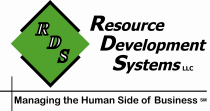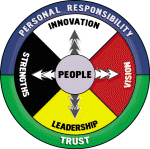Our Research

Discovering the Systems of Organizational Performance Dynamics™
In January 2002 we began a search to discover what made the difference between the performance of average, mediocre organizations, and the performance of exceptional organizations. We wanted to insure that our answer wasn’t based on the most recent fad, but founded in solid research. Over the next 3 years we reviewed the research reports on every study that we could get our hands on, paying particular attention to larger-scaled, long-term studies.
Our approach was different than most; instead of looking at the differences across the studies, we were looking for the similarities. As we began to review and catalog the studies we began to see a pattern emerge. First one, and then another one, and then two or three more key elements began to become evident. Eventually we had six, and then finally seven elements that were the key to driving organizational performance.
We continued our research and we now have over 10 years of study and over 1000 research documents reviewed. Not only have the Seven Elements withstood the test of time, we have discovered several other models that come from the interactions with the Seven Elements or work with and support them. We call these models the System of Organizational Performance Dynamics™.
The following is a brief synopsis of our extensive research.
The Seven Elements of High Performance™
-
Put People at the Center of everything you do; employees, customers, and community
-
Build Trust as a foundation
-
Allow Personal Responsibility through individual decision making
-
Share a Vision of an Aligned Purpose, Values, and Goals
-
Create Emotional Connections through Leadership
-
Focus on Strengths and Accentuate the Positive
-
Encourage Innovation, because good enough is not enough
These Seven Elements are the key to becoming a High Performance Organization. But we discovered that it wasn’t enough to be proficient in a few of these elements and ignore the rest. We discovered that these Seven Elements existed in a symbiotic relationship, and that the most successful organizations learned how to make them work well together so that they could achieve their goals. This relationship is represented by the model to the left.
You can read more about these Seven Elements in our whitepaper The Dynamics of High Performing Organizations or in our book Leadership Lessons From the Medicine Wheel: The Seven Elements of High Performance.
After we published the whitepaper we received contact from the US Navy's Center for Naval Leadership. They told us that they were in the process of redesigning all of their leadership programs, had read our whitepaper, loved our model and wanted permission to use it in their new programs. Of course, we said yes. We are very proud that we are assisting the women and men of the US Navy to be more effective leaders.
Read a Letter from the Navy about the model's continued use
The Seven Elements of High Performance™ have also been adopted by a number of other organizations to provide a foundation for leadership development. Some of these include the Aboriginal Affairs and Northern Development Canada, AFOA Canada, and many university business schools, including Stetson University.
The Payroll Efficiency Factor™
As we continued our research we discovered that not only is there a performance difference between average organizations and the best ones, but there is also a difference in the number of engaged employees between the two. The average organization has only 1 employee out of every 4 that is willing to be a committed, competent, team player who is proactive, innovative, and responsible. The rest are doing just what they have to do in order to stay out of trouble. They do what they are told, but take no initiative on their own. There is also a segment of this population that actually doesn’t like the organization, doesn’t care if it is successful, and is even willing to actively hurt it.
Several of the researchers made the claim that because of these numbers that the average organization was throwing away one-third of their payroll. We this seems reasonable, we needed to find a way to show this is really the case. Based on some of our work with managers we created a metric that measures the impact that engaged, unengaged and actively disengaged employees have on organizational performance. This metric is the Payroll Efficiency Factor™, and measures how efficient the organization's investment in their human capital is having on their performance.
The average organization has a Payroll Efficiency Factor™ of only 63%, meaning that for every 100 employees the organization is paying for but not getting about $1.5 million in work;. We call this the Cost of Lost Engagement™. The best organizations have a dramatically higher Payroll Efficiency Factor™ of 78%. This means that they are 24% more efficient than the average organization, and have about half of the Cost of Lost Engagement™, recovering about $950,000 of their payroll.
You can read more about the Payroll Efficiency Factor™ in our whitepaper The Cost of Being Good Enough.
Performance Dynamics Management Model™
One thing that we quickly learned is that management is a key to creating the environment that is essential for creating employee engagement and organizational high performance. Too often the importance gets lost in the difference between being a manager and being a leader. To be sure, Leadership is one of the Seven Elements of High Performance™. Being a leader is definitely important to a manager's success, but it is only part of what a manager has to do. A manager has to focus both on the systems and processes and the technical side of the organization, which is where most managers place their focus. But this has to be balanced with the role of being a Leader, and creating the emotional connections that are essential for employee engagement.
From this discovery we developed a new way to look at the competencies of being a manager based on two roles: that of being a Builder and Creating Sustainable Systems; and that of being a Leader and Creating Emotional Connections. there are also two Attentions for Performance: Performance Now, and Performance for the Future.
We believe that this model provides a simpler, easier to use model for manager development and decision-making tool for behaviors and actions by that manager.
You can read more about this model in our article Manager vs. Leader and our soon to be released book Rising Above Mediocrity: The Path to Performance.
Whole Person Dynamics™
If we are going to put People at the Center, then we need a simple but powerful model that will help us better understand, interact, and build better relationships with people. Whole Person Dynamics™ is such a model.
You can read more about this model in our whitepaper DISC and Whole Person Dynamics™ and our soon to be released book Rising Above Mediocrity: The Path to Performance, and our planned book for 2014, Whole Person Dynamics™.
The DISC Model of behavioral styles is a related model, and you can learn more about it here.
The Diamond of Engaged Performance™
There are a lot of ways to increase performance. You can threaten people with punishment and drive them hard. But once people find a way to get away from this sort of toxic environment they leave, resulting in the cost of turnover, which is about $30,000 for every $10 in salary that the position pays. You can offer huge rewards, such as high pay, benefits, and bonuses, but this only works as long as the person can actually earn these things or until someone else offers them something better. In the meantime, they quickly learn how to play the system to get the most rewards.
Either approach results in a huge cost to the organization and an unreliable approach for insuring future high levels of performance. Unfortunately, the average organization seems to rely a bit on both approaches to get results. But there is a better way.
As shared above, engaged employees have a dramatic impact on organizational performance. These employees don't need to be bribed or threatened to do a good job because they have an emotional connection to the organization, its Purpose, Values, and Goals. But what do managers need to do in order to get employees engaged?
We discovered that four of the Seven Elements work together to create employee engagement: Trust, Vision, Strengths, and Personal Responsibility. We call this the Diamond of Engaged Performance™ because when linked together in the model we end up with a diamond.
You can learn more about Diamond of Engaged Performance™ in our soon to be released book Rising Above Mediocrity: The Path to Performance.
The CORE Training Approach™
Our research findings are clear; while training can impact the individual, many training programs fail to impact organizational performance. If we are going to make a difference in organizational performance, then training programs must overcome the limitations that keep them from translating learning into performance. This means that we need a different approach if we are going to insure an impact on organizational performance.
That approach is the CORE Training Approach™, which addresses the kinds of training programs we should be focusing on (Culture, Operations, Relationships, and Engagement), but also the strategy we should be using to deliver these programs.
You can read more about the CORE Training Approach™ in our whitepaper Training's Role in Achieving High Performance.
The Research Continues
As we continue to monitor ongoing research by others, as well as apply our research findings to our work with our clients, we continue to learn and understand the dynamics of high performance organizations. And as we continue to learn we will continue to share that learning.

